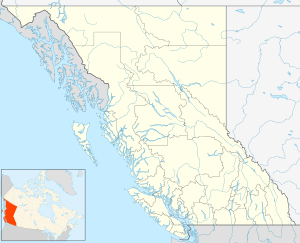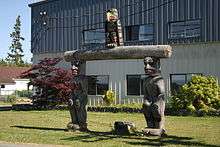Fort Rupert
| Fort Rupert | |
|---|---|
 Fort Rupert Location of Fort Rupert in British Columbia | |
| Coordinates: 50°41′40″N 127°24′43″W / 50.69444°N 127.41194°WCoordinates: 50°41′40″N 127°24′43″W / 50.69444°N 127.41194°W | |
| Country |
|
| Province |
|

_house_decorated_with_three_designs%2C_Fort_Rupert_Indian_Reserve_1%2C_British_Columbia_(706_LS)_(cropped).jpg)
Fort Rupert is the site of a former Hudson's Bay Company fort which was built and first commanded by William Henry McNeill in 1849 and later by John Work. It is located near present-day Port Hardy, British Columbia on Vancouver Island.
The community was named after Prince Rupert, the first governor of the Hudson's Bay Company. The company attempted to exploit a local coal seam in 1851 but gave up the attempt the following year and moved its operation to Nanaimo. Robert Dunsmuir, later a coal baron and father of BC Premier James Dunsmuir, began his life in British Columbia as a labourer in Fort Rupert with the Hudson's Bay Company.
Cannons
On June 6, 1889, the fort burned. Its charred remains were soon overgrown and all that remained was the huge stone chimney. The Nahwitti natives, who lived nearby, salvaged anything useful from the ruins, including metal objects such as knives, nails, hammers. They also took the iron and brass eight-pounder cannons and kept them in their village, Ku-Kultz.
In World War II an airforce base was established several miles from Ku-Kultz. Some of the servicemen learned about the cannons and after the war they started to disappear. By the 1960s only three cannons remained at Ku-Kultz and by the end of that decade, only two pieces were left. In 1976 the only cannon left overlooked the bay and it was taken to Vancouver by fishing boat. This cannon is the only authenticated Hudson's Bay Company brass piece in Canada. Later, some scuba divers stumbled across six cannons on a sandy beach of an isolated bay in the region.[1]
First Nations
The present day village of Fort Rupert is a historic Kwakwaka'wakw village of the Kwagu'ł (Kwagyewlth or Kwakiutl) and the Komoyue subgroup where the opportunity exists to see native carvers working on totem poles or other artwork and traditional crafts. The band government of the Kwagu'ł is the Kwakiutl First Nation.
This is also the home to the famous Glenn Morris and his dad, John Jake.
Petroglyphs, though difficult to find, do exist on the sandstone formations in the higher tidal zones below the old Hudson's Bay Fort site.
See also
References
- ↑ Barlee, N.L. (1976). Historic Treasures and Lost Mines of British Columbia. Canada West.
|access-date=requires|url=(help)